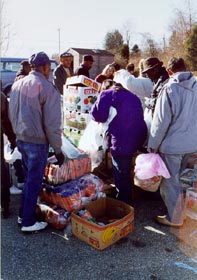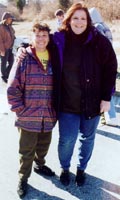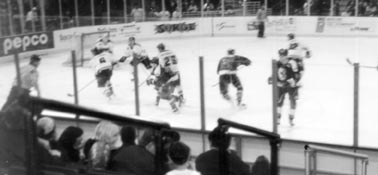
Dock of the Bay

Volume VII Number 6
February 11-17, 1999
Food Link's Modern Miracle of Feeding the Hungry
photos by Mark Burns
Volunteers sort boxes of food donated by Jessup Wholesalers and trucked
to A.A. Co. Farmers' Market.
It's a cold and blustery Friday morning, and a small crowd of bundled people have nothing better to do than stand around a parking lot.
That's because they're waiting for a tractor-trailer laden with fruits and veggies to meet them at the Anne Arundel County Farmer's Market. Once the truck arrives, they waste no time unloading 25,000 pounds of packaged green leaf lettuce, romaine lettuce, eggplants, carrots, green onions, salad mix, watermelons and hot peppers. Bananas and potatoes are part of the mix, too, especially coveted for their relative rarity and broad appeal.
"Some days it's very hard when we have small quantities of produce everybody wants," says Olga Bejaiano, the volunteer overseer at the drops and an Hispanic community activist.
"It's very light today," says Cathy Holstrom, program director
for Food Link. Today's load is divvied up by volunteers from 29 kitchens
throughout Anne Arundel. Typical mornings see reps from 35 to 42 kitchens
splitting a take of anywhere from 25,000 to 50,000 pounds of produce. The
biggest load so far was 70,000
pounds.
70,000
pounds.
The food drops are a weekly routine for Food Link, a food rescue operation that, since 1991, has spread from Anne Arundel into Talbot, Dorcester and Queen Anne's Counties on the Eastern Shore - though Anne Arundel is still the only county with a wholesale produce program.
All of the produce delivered to the Anne Arundel Farmer's Market comes from Jessup Wholesalers to be evenly distributed among the volunteers who stop in to stock their kitchen pantries. Still more comes from pick-ups at donating markets and restaurants. Everybody wins; the produce fills needy stomachs rather than landfills, food kitchens have a tool for stretching their dollars, donators get tax write-offs plus positive publicity.
Its win-win formula has made Food Link a roaring success. In its first year, 1991, it rescued and redistributed 33,000 pounds of perishables headed for the garbage heap. Last year the total topped three million pounds. Nearly two million of that total was rescued from Jessup Wholesalers.
"It occurred to us in 1994 that we could salvage wholesale produce," said Holstrom. Since then the volume Food Link handles has skyrocketed.
Handling that mass of salvaged food takes coordinating an army of volunteers, donators, food inspectors and truck drivers. "When I first came here, I thought it would be difficult to find volunteers," says volunteer coordinator Paula Schulz. "Actually, it's easy to find people who like Food Link and want to help."
Despite the outpouring of goodwill, not all offerings of food are accepted; donated perishables are typically close to the end of their shelf lives and have to be used quickly. "There's a lot of food we're offered that just isn't good enough," says Holstrom. "You have to keep in mind that we feed people."
Their knack for feeding the needy effectively and efficiently has earned Food Link a national reputation backed up by awards. They've served as a model for similar efforts across the US and have even inspired a spirit of volunteerism in a pair of two Japanese educators who visited on exchange recently.
 "They were a captive audience,"
says Holstrom. "In Japan there's no volunteering and not a lot of social
service or charities." Apparently, the two men were so impressed that
they left with intentions to establish Food Link Japan. Back home, however,
the pair live 400 miles apart. Because of geography, if nothing else, nothing's
expected to happen with their project before March.
"They were a captive audience,"
says Holstrom. "In Japan there's no volunteering and not a lot of social
service or charities." Apparently, the two men were so impressed that
they left with intentions to establish Food Link Japan. Back home, however,
the pair live 400 miles apart. Because of geography, if nothing else, nothing's
expected to happen with their project before March.
Closer to home, Food Link is building communities as well as feeding hungry stomachs. With its community connections, it is branching out by helping Social Services with cases, sponsoring winter coat drives and reaching out to families of kids with AIDS during Christmas.
Will Food Link have to change its name if the coat and toy drives take off as dramatically as the food rescue?
Food rescuers Olga Bejaiano and Cathy Holstrom. photo by Mark Burns
Holstrom laughs. "We have talked about whether it's time to change the name and our mission statement. But it doesn't matter as long as we're recognized in the community."
- Mark Burns
To volunteer or donate call 410/222-7853.
Cool 'Altones' Jazz Backs Hot Kornheiser on ESPN Radio
Chesapeake Country's lively jazz band, Roy Battle
and The Altones, is playing the nation. Opening for ESPN radio's "Tony
Kornheiser Show," they're heard on 90 stations 'round the country.
"They're our official house band," says Washington Post columnist and ESPN radio personality Kornheiser of the four-piece combo with volcalist. "We love them."
What's not to love? The band's smooth mix of '30s, '40s and '50s tunes have kept Marylanders entertained for over four decades.
The Altones' current leader, LeRoy Battle, of Lothian, is a man of many hats. He's been a jazz musician since his childhood days in Harlem and Brooklyn, New York. As a young man, he studied at the famed Julliard School of Music.
In between, he trained for service in World War II as one of the famous Tuskegee Airmen, African Americans who fought their war in the air. The war ended before Battle could serve, but at home he joined the Tuskegee Airmen's landmark protest against discrimination in the military.
Battle came to Maryland to attend Morgan State College. He taught in the Prince George's county schools, directing an award-winning marching band for many years. In the early '50s, Battle was invited to play drums with the Altones he now leads. Today's Altones include Dennis Davis, retired Naval Academy musician, on tenor saxophone; Dick Glass on keyboard and trumpet, Jim Cunningham on bass, and Marilyn Carlson, vocals; with Bob Price, Gary Malveso and Judy Glass standing in.
Now 77, Battle continues to deliver with his "very dance- and swing-oriented" band.
He's not a man who expects things to come easy, as you learn from the title of his 1995 autobiography, Easier Said. But landing the gig as house band for Kornheiser's nationally syndicated radio show was easy. "On a whim I sent my tape in," says Battle. "A couple of days later they called me."
There was no contest according to Kornheiser: "My producer played it, and I loved it. It's great listening music."
Postscript: Long-time Altone bass player Jack King died on Feb. 8. "Jack had a huge talent. Not a big talent. Not a great talent. A huge talent with a musician's beat on that melodic bass that he played. He could play anything. He also had a great personality and a great heart," noted his friend and fellow musician of over three decades, Roy Battle.
Jack King, shown above with his beloved band, will be buried Monday Feb. 15 at 11am at First Baptist Church in North Brentwood.
Hear The Altones Valentine's Day from 7pm at Copelands, Annapolis. Hear Tony Kornheiser weekdays on ESPN Radio's Washington affiliate, WTEM SportsTalk 980, from 4-7pm.
-Darcey Dodd
Too Hot for You? Icebreakers Give Chills, Thrills and Spills
photos by Nathaniel Knoll Chesapeake Icebreakers delivers action to the fans, and mascot Frostbite brings the action to the stands.
The Washington-Baltimore region gives sports fans
many a team to root for. But who do we cheer during these long winter weeks
when Superbowl Sunday has come and gone, our Orioles and Baysox have headed
south and the NBA season is reduced to a mere 50 games?
Try hockey - and you'll soon find The Capitals are not the only game in town. In Chesapeake Country the roar of the crowd is "Go Icebreakers!"
Professional hockey in Maryland? That's right, and while we haven't seen many ice-coated surfaces this winter, The Show Place Arena in Upper Marlboro has showed plenty to the some 2,400 hockey fans who fill the arena each game. In fact, an ice rink full of the slick stuff.
Joining the East Coast Hockey League in 1997, The
Chesapeake Icebreakers are now in their second season. They're minor league
affiliates of the first-tier National Hockey League's Tampa Bay Lightning
and the second-tier American Hockey League's Hershey Bears. An outstanding
inaugural season took the Icebreakers to the first round of the playoff
series. This year's play is proving as action-filled as last year's; three-fourths
through the season this week, they were 23-20-5.
The
Chesapeake Icebreakers are now in their second season. They're minor league
affiliates of the first-tier National Hockey League's Tampa Bay Lightning
and the second-tier American Hockey League's Hershey Bears. An outstanding
inaugural season took the Icebreakers to the first round of the playoff
series. This year's play is proving as action-filled as last year's; three-fourths
through the season this week, they were 23-20-5.
The league's season began in mid-October and ends in April. With playoffs approaching and 25 teams competing for the league title, The Kelly Cup, the ice is getting hot.
As team mascot Frostbite works the crowd into a frenzy, the announcer's call of "get ready for an Icebreaker's power play" echoes throughout the arena. Six skaters speed to the other side of the rink, and the puck is fired through an opening in the opposing goal's defense. Fans roar at the game-winning goal.
The Icebreakers' home rink, The Show Place Arena, is conveniently located at the intersection of Routes, 4 and 301. Parking is free. Tickets, starting at $13 and $9 for seniors and children, are not cheap but certainly discounted from major-league prices. What's more, it's family entertainment.
"It's close, exciting and there's not a bad seat in the house," concluded hockey fan Michael Kimlicko of Fairhaven, after a winning game.
-NMK
In Washington, the U.S. Public Interest Research Group last week put Maryland on a list of 16 states that have weak standards for warning of mercury pollution in fish. Virginia and Pennsylvania were on that list of less notables like Alabama and Mississippi - all of which have low thresholds for contamination. That means they don't warn us often of mercury-contaminated fish ...
Pennsylvanians, like Virginians, have had it with importing so much New York trash. So last week, legislative staffers and activists sent 50 pounds of shredded office paper special delivery to New York City Mayor Rudy Giuliani ...
In Minnesota, we know that Gov. Jesse "The Body" Ventura is bad. But the New Mexico Senate thinks that its governor, Gary Johnson, is so tough that they passed a resolution calling for Ventura and Johnson to wrestle. If Johnson wins, New Mexico gets all of Minnesota's 10,000 lakes. If "The Body" prevails, Minnesota gets 10,000 New Mexico sand dunes. Remarked Johnson: "Aren't I going to get killed?" ...
Our Creature Feature comes to us from the hills around San Francisco, where the wild pigs are gaining control. But perhaps not for long, because the San Francisco Public Utilities Commission declared war on them by hiring a professional feral animal control specialist to hunt them down.
The commission says the wild pigs are tearing up the East Bay hillsides and threatening the region's water supply at the Calaveras and San Antonio reservoirs.
Their conclusion: "It's time to start makin' bacon."
| Issue 6 |
Volume VII Number 6
February 11-17, 1999
New Bay Times
| Homepage |
| Back to Archives |